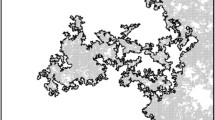Abstract
We consider some models of classical statistical mechanics which admit an investigation by means of the theory of dominant ground states. Our models are related to the Gibbs ensemble for the multidimensional SOS model with symmetric constraints ∣φ x ∣ ⩽m/2. The main result is that for β⩾β0, where β0 does not depend onm, the structure of thermodynamic phases in the model is determined by dominant ground states: for an evenm a Gibbs state is unique and for an oddm the number of space-periodic pure Gibbs states is two.
Similar content being viewed by others
References
G. M. Louth, Stochastic networks: Complexity, dependence and routing, Ph.D. thesis, Statistical Laboratory, Department of Pure Mathematics and Mathematical Statistics, University of Cambridge (1991).
T. Kohonen,Self-Organisation and Associative Memory (Springer-Verlag, Berlin, 1984).
E. I. Dinaburg, A. E. Mazel, Ya. G. Sinai, The ANNNI model and contour models with interaction, inMathematical Physics Renews. Soviet Science Reviews C, Vol. 6, S. P. Novikov, ed., (Gordon and Breach, New York, 1987), pp. 113–168.
J. Bricmont and J. Slawny, Phase transitions in systems with a finite number of dominant ground states,J. Stat. Phys. 54:89–161 (1989).
A. G. Basuev, Hamiltonian of the phase separation border and phase transitions of the first kind. I,Theoret. Math. Phys. 64:716–734 (1985); Hamiltonian of the phase separation border and phase transitions of the first kind. II. The simplest disordered phases,Theoret. Math. Phys. 72:861–871 (1987).
J. Bricmont, A. El Melouki, and J. Frohlich, Random surfaces in statistical mechanics: Roughening, rounding, wetting,...,J. Stat. Phys. 42:743–798 (1986).
J. Slawny, Low-temperature expansions for lattice systems with many ground states,J. Stat. Phys. 20:711–716 (1979).
E. I. Dinaburg and A. E. Mazel, in preparation (1990).
A. E. Mazel and Yu. M. Suhov, in preparation (1991).
D. G. Martirosian, Uniqueness of Gibbs states in lattice models with one ground state,Theoret. Math. Phys. 63:511–518 (1985); On the influence of the border field in one ground-state models,Izv. Akad. Nauk ArmSSR 42:563–591 (1987) [in Russian].
J. Bricmont, K. Kuroda, and J. Lebowitz, First order phase transitions in lattice and continuous systems: Extension of Pirogov-Sinai theory,Commun. Math. Phys. 101:501–138 (1985).
E. I. Dinaburg and Ya. G. Sinai, Contour models with interaction and their applications,Selecta Math. Sov. 7:291–315 (1988).
R. Kotecky and D. Preiss, Cluster expansion for abstract polymer models,Commun. Math. Phys. 103:491–498 (1986).
M. Zahradnik, An alternative version of Pirogov-Sinai theory,Commun. Math. Phys. 93:559–581 (1984).
Author information
Authors and Affiliations
Rights and permissions
About this article
Cite this article
Mazel, A.E., Suhov, Y.M. Random surfaces with two-sided constraints: An application of the theory of dominant ground states. J Stat Phys 64, 111–134 (1991). https://doi.org/10.1007/BF01057870
Received:
Issue Date:
DOI: https://doi.org/10.1007/BF01057870



